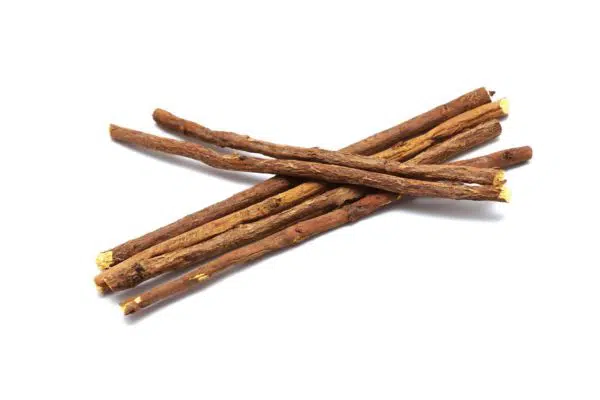
You may have enjoyed it as a child in candies, but did you know that licorice root is also
great for skin? A treasured natural remedy for a number of health issues, licorice has only recently been discovered as helpful for people with sensitive skin, as well as to lighten and brighten your skin's look.
Who knew this plain-looking root could be so useful?
what is licorice root?
Licorice is the root of a plant called Glycyrrhiza glabra, a legume related to beans and peas that is native to southern Europe and parts of Asia. It likes well-drained soils with full sun, and is harvested about two-three years after planting.
A perennial, it grows to 3-7 feet high, with feather-like leaves 3-6 inches long and purple to pale whitish blue flowers. The fruit is small—only about 1 inch long—with several seeds inside.
HOW IS IT USED?
The root is what's typically used for both its health benefits and skin care benefits. The extract is produced by boiling the root, evaporating most of the water, and saving the remaining syrup.
A compound in the syrup called “glycyrrhizin” is a sweetener considered to be much sweeter than sucrose, which also has health benefits.
internal health benefits of licorice root
Licorice root has been used historically for a number of ailments, including asthma, fatigue, depression, colds and flu, gingivitis and tooth decay, heartburn, liver problems, sore throat, ulcers, and arthritis.
Many of these uses still apply today. The National Institutes of Health notes that licorice is used for a variety of digestive problems, including stomach ulcers, heartburn, colic, and chronic gastritis. The University of Maryland Medical Center notes there is mixed evidence about whether it works for stomach ulcers, but a few studies have found that a certain type of licorice called “deglycyrrhizinated” licorice, along with antacids, helped treat ulcers.
ALTERNATIVE USES
Other current uses include canker sores—a small study showed that people who gargled four times a day with licorice dissolved in warm water experienced pain relief—indigestion and GERD, upper respiratory infections, and depression.
Some small studies have indicated that licorice root extract may suppress the viral activity of the herpes simplex virus, which causes cold sores.
SIDE EFFECTS
Though considered mostly safe, people who consume large amounts of licorice for more than four weeks (30 grams or more daily) can experience side effects like headaches, high blood pressure, low blood potassium, weakness, and paralysis. Those who have heart disease or kidney disease are more at risk for these effects.
licorice root's benefits to the skin
Licorice root has a good reputation as being helpful for sensitive skin. Licorice root contains an active compound called “glabridin.” Licorice extract may also help diminish the appearance of dark under-eye circles, discoloration and age spots.
The extract also has powerful antioxidants that help protect the skin from environmental stressors, as well as “licochalcone,” which helps balance oil, making this a good ingredient for those with oily skin.
https://www.annmariegianni.com/licorice-root-for-sensitive-skin/?utm_campaign=Mar172019%20%5BPM%20Send%5D%20%E2%80%94%2025%25%20off%20Citrus%20Stem%20Cell%20Serum%20%2B%20Ingredient%20Spotlight%20%28HkFwhF%29&utm_medium=email&utm_source=Engaged%20Segment%20%28120%20days%29&_ke=eyJrbF9lbWFpbCI6ICJzaHV0YWxldmFAZ21haWwuY29tIiwgImtsX2NvbXBhbnlfaWQiOiAiZFpkejdqIn0%3D




Комментариев нет:
Отправить комментарий